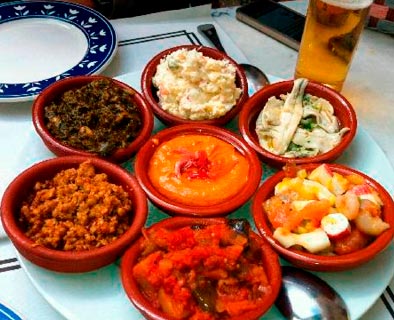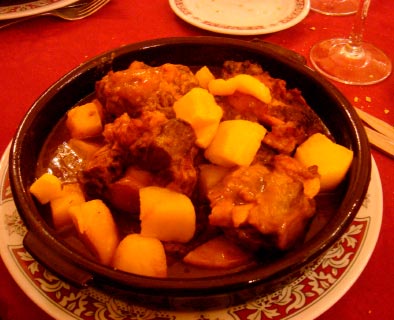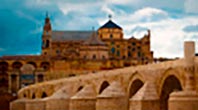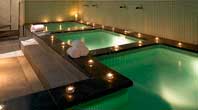Cordoba: Gastronomy
The way Cordoba is geographically located, there is a blend between the products of the Mountain and the flatland; the cuisine from “Sierra Morena” and from the “Guadalquivir” and the “Genil” valleys.
The Mountains supply raw materials, such as game hunting and live-stock breeding. The “Guadalquivir” valley provides the olive oil, the “Montilla-Moriles” and “Doña Mencía” wines, and a big variety of fresh vegetables and cereals. Since Cordoba is located between two seas, the Mediterranean and the Atlantic, it gives Cordoba the opportunity of getting always fresh fish.
Cordoba’s Gastronomical variety is really large. On one side, from the Roman conquest, Cordoba has a Mediterranean cuisine which means the use of olive oil and herbs. Another influence in Cordoba’s gastronomy is the Arab, as in other parts of Andalusia, cooking stewed vegetables that are a meal by themselves, not just an accompaniment of something else. The Arab influence also brought the sweet-sour tastes, the use of almonds, nuts and raisins with the meat and vegetable stews. The Jewish left some of their own dishes, like the “cazuela de habas secas con berenjenas” (dried beans and eggplant), “Gazpacho blanco de harina de habas”, etc. The Christian conquest added their different ways of using and cooking the meat.
This mixture of gastronomic cultural influences, is well noticed with desserts. On one side you have “Mantecados” (small bread desserts made with pork fat) , “Perrunas”, etc., which are the Christian and Castilian heritage. On the other side you have “Alfajores” (dessert made with almonds, nuts and honey) and desserts made with almonds and sugar, which come from the Arab influence.
"Tapas" in Cordoba
 A Tavern in Cordoba used to be a place where local people could go to drink wine. Every tavern used to have an interior courtyard (Interior "Patio") with a well, that was not only used to decorate but also to refresh the drinks.
A Tavern in Cordoba used to be a place where local people could go to drink wine. Every tavern used to have an interior courtyard (Interior "Patio") with a well, that was not only used to decorate but also to refresh the drinks.
In 1721 Cordoba already had more than 143 Taverns. Towards the end of the century, Cordoba had a song:
Cordoba, brave city, that between old an new, has three hundred taverns and only one bookshop.
Cordoba is one of the best towns for "Tapeo". You can find excellent "Tapas" at very plain bars and also at the very modern ones. There is a large variety of "Tapas"; but remember that here in Cordoba you can have the best "Flamenquines", "Salmorejo", "Rabo de Toro" (Bull's tail), "Eggplants with honey", etc. you will ever try.
If you want a few tips on what taverns to go to for a meal or a "Tapa", here we propose some of them: "Salinas" tavern, "San Miguel ", "Pepe el de la Judería", "La Viuda" (The widow) and of course "El Círculo de Plateros".
Meats in Cordoba
 To the North of Cordoba’s province there is the “Valle de los Pedroches” (the “Pedroches” Valley) next to another province, Extremadura, which provides the city with the best cattle and excellent lamb.
To the North of Cordoba’s province there is the “Valle de los Pedroches” (the “Pedroches” Valley) next to another province, Extremadura, which provides the city with the best cattle and excellent lamb.
The type of lamb that is raised at Cordoba has to be used when its still young and it is best eaten stewed better than in the oven. You can also find an excellent handmade sheep cheese, similar to the “Manchego” cheese (salty type of cheese original from “Castilla la Mancha” in the middle of Spain). The best pig livestock are raised at this same Valley (the “Pedroches” Valley), at the acorn fields, giving a first-class ham. The well known “Conchifrito” is a meal based on fried finely chopped pig meat. The “Flamenquín” is a mixture of pig and cow meat. This recipe consists of a large pig or cow fillet rolled up in ham, then dipped in breadcrumbs and finally fried.
One of the most popular dishes in Cordoba is “El rabo de toro” (the Bull’s tail). It is a stew made with the bull’s tail; its jelly makes the sauce thicker. Sausages can be made in two different ways, depending on whether they are made at the mountains or at the flatland.
At the mountains, the “Chorizo” and the “Morcilla” (“Chorizo”: made of lean and pork fat with red and white pepper and garlic, “Morcilla”: black sausage made mainly with blood and fat of pork and onions) are prepared smoked. At the flatland, called “Campiña”, the blood and onion “Morcilla” is boiled. One of the best of its kind is the “Baena” one. The “Chorizo” can be eaten raw, fried or boiled with wine and thyme.












